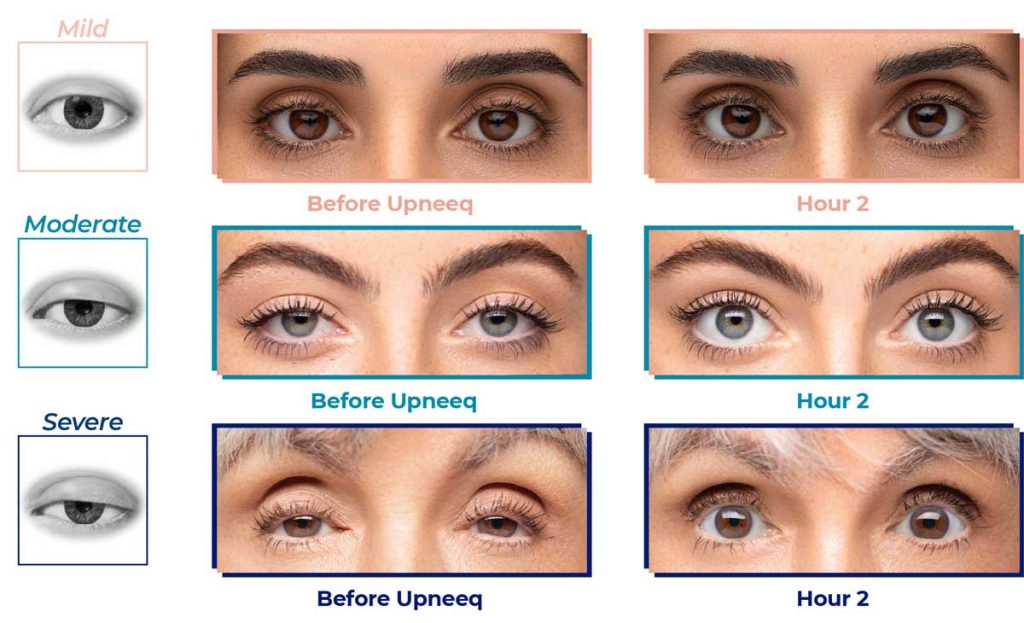SOT Therapy: Life-Changing Treatment for Those Who Suffer From Chronic Infections
Lyme, CMV, and Multiple other Bacterial, or Viral infections What is SOT THERAPY? SOT (Supportive
Are low-lying eyelids making your eyes look a little tired? You may have acquired ptosis.
Upneeq is the only FDA-approved prescription eyedrop for acquired ptosis (low-lying lids) that lifts your upper eyelids to open your eyes.
Acquired ptosis (low-lying lids) is a common medical condition that:
In addition to affecting your appearance, low-lying eyelid(s)
can also impact your eyesight by reducing your field of
vision. Low-lying lids may lead to issues with:
Day-to-day functioning
◇ Reading
◇ Driving
◇ Computer use
Appearance
◇ Looking tired
◇ Asymmetrical eyes
◇ Cosmetic concerns


*Two randomized, multicenter, double-masked, vehicle-controlled, Phase 3 studies compared once-daily Upneeq in 304 subjects with acquired blepharoptosis. Efficacy was assessed by points seen in the superior visual field using the Leicester Peripheral Field Test (LPFT) and photographic measurement of Marginal Reflex Distance-1 (MRD-1). Actual patient images courtesy of Dr. Raymond Douglas. Individual results may vary. Average upper eyelid lift with Upneeq in clinical trials was 1mm.*2There was a statistically significant difference in mean change in the number of points seen in the superior visual field from baseline after instillation of Upneeq and vehicle, with significantly greater increases in the study eye of the Upneeq group evident at the 2-hour point and maintained at the 6-hour time point. Greater eyelid lift (increased MRD-1) was observed for the Upneeq group than the vehicle group on Day 1 at 6 hours post-dose and on Day 14 at 2 hours post-dose.1
Upneeq is a prescription product. Please speak with your doctor for more information.
UPNEEQ® (oxymetazoline hydrochloride ophthalmic solution), 0.1% is a prescription eyedrop used to treat low-lying lids (acquired blepharoptosis) in adults.
• Low-lying lids may be related to conditions such as stroke and/or brain aneurysm, Horner syndrome, myasthenia gravis, loss of the ability to move eye muscles, eye infection and eye tumors. Ask your doctor if you have any of these conditions. • UPNEEQ is a type of medication that may affect your blood pressure. If you have heart disease, uncontrolled high or low blood pressure, or feel faint at rest or when quickly standing up, you should call your doctor if your symptoms get worse. • Patients with reduced blood flow to the brain or heart, or patients who experience eye or mouth dryness due to an immune system disorder (Sjögren’s syndrome), should use care when taking UPNEEQ. Call your doctor immediately if you feel your symptoms may be getting worse. • UPNEEQ may increase the risk of eye pressure due to fluid buildup (angle-closure glaucoma) in patients with untreated narrow-angle glaucoma. Call your doctor immediately if you feel increased pressure in your eye after using UPNEEQ. • Do not let the tip of the UPNEEQ vial touch your eye or any other surface. This can help prevent eye injury or contamination. Each UPNEEQ vial is for one-time use and should be discarded after being used.
The most common adverse reactions with UPNEEQ (occurring in 1-5% of patients) were eye inflammation, eye redness, dry eye, blurred vision, eye pain at time of use, eye irritation, and headache.
• Your doctor should review your full medical history before prescribing UPNEEQ. • UPNEEQ belongs to a class of medication (alpha-adrenergic agonists) that may affect your blood pressure. Use UPNEEQ carefully if you currently take an alpha-adrenergic antagonist medication to treat heart disease or an enlarged prostate. Patients taking beta-blockers, or other medications to treat hypertension or an abnormal heartbeat, should also be careful when using UPNEEQ. • Patients who use a certain class of antidepressant medication (monoamine oxidase inhibitors) should also be careful when using UPNEEQ, as it may affect the way your body absorbs the medication. These are not all of the possible side effects of UPNEEQ. Tell your doctor if you have any side effect that bothers you or does not go away. Call your doctor for medical advice about side effects.
The only FDA-approved prescription eyedrop
for acquired ptosis (low-lying lids) that lifts your
upper eyelids to open your eyes
Lyme, CMV, and Multiple other Bacterial, or Viral infections What is SOT THERAPY? SOT (Supportive
Regenerative medicine has revolutionized the treatment of orthopedic injuries. Platelet-rich plasma (PRP) therapy and stem
When it comes to life after pregnancy, moms all over the world attempt to reclaim
For women, aging can be a frightening experience. Their concerns, extend beyond wrinkles and fine

If you have any questions or comments regarding Bluegrass Preventive Medicine in Lexington Kentucky, please contact us or visit us on social media.